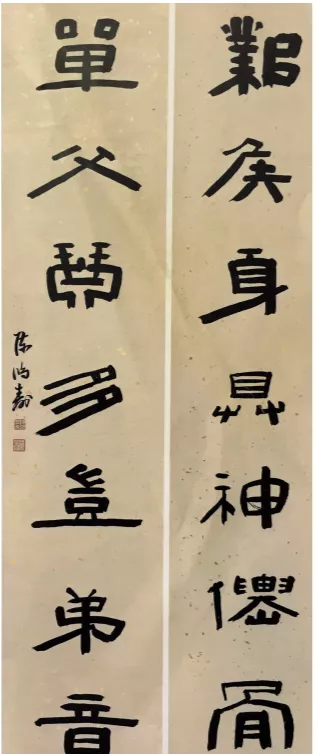
▌ Chen Hongshou's "Seven Words of Lishu Lian" Beijing Kuangshi 2018 Spring Auction Lot
Chen Hongshou (1768~1822), born in Hangzhou, was originally named Hongxu, Zigong, Mansheng, also known as Mangong, Manshou, Jiagu Pavilion Chief, Seed Yu Cyclist, West Lake Fisherman, etc.
There are kinds of Yuxian Hall, Amanda Room, and Sanglian Li Hall (Xiao Jianmin's "Chen Mansheng Research"). He is the author of "Poetry Collection of Sanglian Liguan", "Seal of Seed YuXianGuan", "Poetry Of Kind YuXianguan" and so on.
▌ Chen Hongshou's "Seven Words of Lishu Lian" print
His seal carvings went in and out of the Qin and Han Dynasties, and he was one of the famous "Eight Houses of Xiling", good at landscapes and flowers, and his calligraphy was famous, with Lishu as the best. He is also known for his innovative design of purple sand pots, and perfectly combines poetry, calligraphy and painting with purple sand pottery, carving poems and paintings on the pots, which are called "Mansheng pots" by posterity, and are the pioneers of the purple sand literati era.
▌ "Chinese Calligraphers and Painters Seal Recognition" Chen Hongshou Seal No. 65, 75
Chen Hongshou lived in the Qianjia period, which was the end of the Taiping era of economic development in the Qing Dynasty, and it was also a period of great prosperity in artistic activities. He had close contacts with Zhu Hongkai, Zhu Peng, Yuan Ming, Qian Yong, Guo Lu, Tu Zhuo, Xi Gang, Chen Yuzhong, etc., and was deeply influenced by Yuan Ming's "theory of sexual spirit", advocating a free and accessible, independent and uninhibited artistic personality, and the realm of "poetry to the long taste of no heart". Chen Hongshou was deeply respected by Ruan Yuan, entered the political arena as Ruan Yuan's staff, was influenced by Ruan Yuan's artistic ideas all his life, and was a practitioner and advocate of epigraphy and epigraphy in the Qianjia period (Xiao Jianmin's "Chen Hongshou Research").
▌ Chen Hongshou's "Seven Words of Lishu Lian" Xiao Mang Cang Cang Zhai Old Collection
Chen Hongshou is proficient in various types of calligraphy, the more common being Xingshu and Lishu. Its affiliation is unique in the "Nine Houses of Qingli", simple, interesting, unconventional and fresh, elegant and ancient. As far as the form of specific calligraphy is concerned, the pen is strong and strong, and the horizontal, skimming, and stretching are more than the Yellow Valley; the glyph side posture is balanced and interesting. His lishu can be said to be the embodiment and crystallization of his artistic propositions. Calligraphy since the Second King opened the road of Yanli, after the Jin and Tang Dynasties, the scribes mostly inherited the Second King, and the style of calligraphy was flattered and weakened until the Qing Dynasty. Chen Hongshou and other heavy stele calligraphers just in the yanmei environment to remove weakness, and strive for bone strength and innocence.
▌ Part of "Ode to the Stone Gate"
His calligrapher Fa Han Li famous monument "Zhang Qian Stele", "Shi Men Song", "Yang Huai Table", "Opening the Chu Chu Dao", "Qi Sangong Mountain Stele", "Kong Zhou Stele" and so on. "Zhang Qianbei", condensed and simple, with a circle in the square, calm and agile. "Kong Zhou Stele", the glyphs are regular and beautiful, the knot body is small and large, the middle palace is tightened, and the wave picking of some words is very ethereal and unrestrained. Chen Hongshou has a simple and elegant temperament in the two steles, and the calligraphy has not changed much, skimming and stretching, absorbing the characteristics of small and large fonts and diverse postures.
This article was edited and compiled from Hong Jihong's article "Chen Hongshou Lishu Seven Words Joint Examination", which has been deleted and deleted, and the original article was published in the January issue of Collections in 2019
Collectible was founded in 1993 with a volume in hand to grasp the collection
WeChat name: Favorite magazine
WeChat ID: sczz029
"Collection" Weibo ID @ Collection Magazine